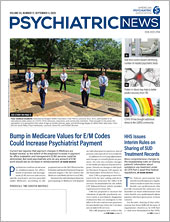The early weeks of the COVID-19 pandemic were rife with challenges for inpatient psychiatric care. Neither the open layouts found in many psychiatric units and facilities nor the traditional elements of inpatient treatment, such as group therapy, were conducive to infection control, yet psychiatric patients who tested positive for the virus still needed care. To meet the demand, some hospitals and inpatient psychiatric centers converted units that were in low demand into units specifically for psychiatric patients who tested positive for COVID-19.
Hartford Hospital in Hartford, Conn., turned a six-bed children’s unit into a COVID-19 psychiatric unit after other options were deemed unsatisfactory, said John Santopietro, M.D., the senior vice president of Hartford HealthCare and physician-in-chief of the Behavioral Health Network.
“We had three choices: We could admit COVID-positive psychiatric patients to medical units with [care by] consultation-liaison psychiatrists, admit COVID-19-positive psychiatric patients to general psychiatric units and keep them isolated, or create a COVID-positive psychiatric unit,” Santopietro told Psychiatric News.
Isolating psychiatric patients may hamper treatment, said Francis Lotrich, M.D., Ph.D., the medical director of West Springs Hospital in Grand Junction, Colo. West Springs, the only psychiatric hospital in western Colorado, opened two wings of an unused building on the grounds to address COVID-related needs, one for patients known to have the virus and one for patients who were symptomatic and suspected of having the virus but whose test results were pending.
“When patients are in a psychiatric hospital, they go to group sessions and participate in group activities. There are communal and social times when they are expected to interact with other patients,” Lotrich explained. “Being isolated can be detrimental to patients’ recovery, so we created the units so these patients could have opportunities to interact with each other.”
Although psychiatrists and mental health professionals can work with patients via telehealth, staff must be prepared for direct patient interaction. During the pandemic, that includes suiting up in personal protective equipment (PPE), which is something they may not be used to doing, Lotrich said. “Patients are [in a psychiatric hospital] because they are acutely ill. They may be aggressive or try to harm themselves or others, and there can be situations where time is of the essence in getting to them,” Lotrich said. “Make sure [staff members] know where the PPE is and are trained in putting it on and taking it off.”
At Yale New Haven Psychiatric Hospital in Connecticut, which converted an adolescent unit to a COVID-19 psychiatric unit, a multidisciplinary leadership team wrote a manual outlining admission criteria for the unit. They also developed protocols for infection prevention, use of PPE, management of physical psychiatric emergencies, group therapy, and in-room meals.
“Having clear protocols helped to subdue the anxiety some of the staff had in delivering care as we rolled out the different facets of the COVID unit,” said Luming Li, M.D., the hospital’s associate medical director of quality improvement.
Hartford Hospital included infection control specialists in planning its COVID-specific units.
“There is a fair amount of variability in what infection control [specialists] recommend from site to site, so it’s important to get their opinion and buy in on what you should do,” Santopietro said.
The best way to recruit staff for a COVID-19 psychiatric unit is to call for volunteers, although some incentives may help, said Michael P. Krupa, Ed.D., the chief executive officer of TaraVista Behavioral Health Center in Devens, Mass. TaraVista converted a pediatric unit into a unit for patients with COVID-19.
“We set up our unit purely with volunteers, but to maintain a steady state of care, we decided to offer short-term financial differentials for the nursing staff,” Krupa explained. “We chose not to use the term ‘hazard pay,’ as there was no evidence that working on the unit was more hazardous than working anywhere else.”
Li said that turning to volunteers first can help preserve morale. “It can be a team-building opportunity. A lot of kudos and recognition goes to the team that helps support the unit, and it highlights the positives of being able to care for this population,” she said.
Throughout the pandemic, leaders of the three New England institutions—Hartford, TaraVista, and Yale New Haven—and other hospitals and psychiatric facilities in the region have maintained contact with each other to share ideas, a practice that Krupa said has been invaluable to improving care and encouraging staff as the pandemic rages on.
“That we’re facing this together even though we work in different institutions is immensely satisfying,” he said. “While we each take internal actions based on our own resources, circumstances, and official guidance, checking in with these wonderful colleagues means we are not going it alone.” ■

